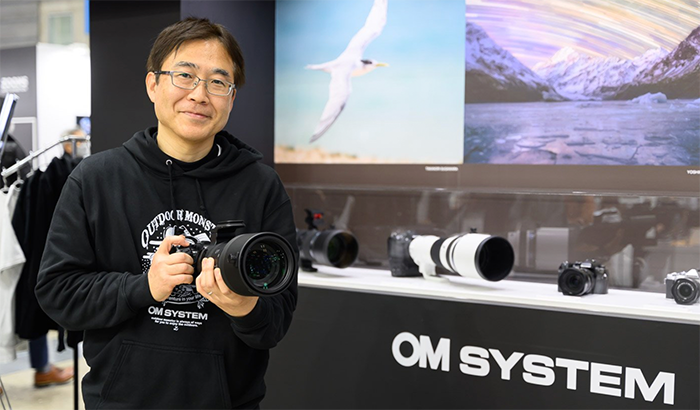
There is a long interview you can read at Personal View. Here I am only reposting the MFT part:
PV: Many members of the ‘Personal View’ community are shooting with the Micro Four Thirds (MFT) system digital cameras including many of the Panasonic MFT system products. Therefore when during the Leica and then Panasonic press conferences prior to the opening of Photokina 2018 we have learned about new L-mount alliance, many of our community members become concern that MFT system is in danger because of these new series of L-mount cameras.
Can you give us some insight on the destiny of the Panasonic MFT products?
Mr. Uematsu: You really should not be concerned about MFT format. L-mount is an addition not replacement of the MFT format. The same situation, for example, in film cameras categories: not only 35mm, but also larger format so called “medium format”. In some special occasions we need large format cameras, especially when large size high quality pictures are required, for instance, for the commercial and industrial photography, fashion or landscape. During the silver halide film era the most popular format was 35mm film, while some others used even larger films for special purpose. The same is with digital imaging. When we introduced the MFT system, at that time its picture quality was comparable with 35mm film, but now, the MFT has much more potential than the 35 millimeter film. If compared with 10 years ago, when we introduced our first MFT camera G1, the current MFT cameras has been improved about 2 f-stops more performance. As you already know, it was possible because of the improvements in sensor technology as well as in image processing algorithms. However, while we have so many improvements in MFT category, some kind of professional photographers want to get more than 40 or 50 megapixels images, especially for making very big prints, when the extra high-quality high-resolution photos are required: commercial, industrial, artistic portraits… It’s not only for the final images, but also during post-processing. For instance, the large pixel images are preferable for photo retouching. The only way to reach that level of image quality without further increasing the pixel density is to go for larger area sensors. For such applications we are introducing the new category, while we also continue development of the MFT. I also believe the MFT has far future. One of the strengths, the advantages of MFT systems is their compact size and low weight. Especially when we talk about the MFT telephoto lenses. For example, a telephoto lens with 800 millimeters focal length for 35mm sensor weights a few kilograms, while for MFT the equivalent lens is less than 1 kg and the MFT cameras are small, so we are looking at a total of about 1.5 kg in weight for the camera plus lens MFT system. I also believe that with progress in sensor technology in very near future many customers will find the advantage of MFT again. However, currently some of the customers also require larger format cameras. In fact large sensor cameras are experiencing the boom.
PV: Will the new L-mount system affect the Panasonic development of new MFT products, for example will some of the proposed MFT lenses be delayed? Another concern is that the MFT could be refocused primarily towards the basic entry-level of cameras, eliminating the semi-professional MFT category of products. Will the MFT cameras have the same attention from the best Panasonic engineers and designers, or it will suffer from lack of resources?
Mr. Uematsu: Of course our resources are limited, but I don’t think it would strongly affect the current MFT developments. That is also why we have an alliance with Leica and Sigma. From the customer’s point of view, it will be good for customers to be able to choose among cameras and lenses from three different companies. It is a matter of internal management to properly redistribute workforces. That being said, our internal management in Panasonic is very good. We certainly will be continuing working on new MFT lenses, even though Panasonic is already offering more than 20 MFT lenses, and together with other lens manufactures there are in total, I think, almost 50 lenses which complement each other. While we already have a normal general purpose lenses, in the future we may focus more on what people call “premium” high-quality fast lenses, like just announced 10-25mm f/1.7 lens. And also we would like to produce more cinema lenses designed for exceptional video quality. Anyway don’t worry, we will continue with MFT and some of the new enhancements, vice versa, might be shared between L-mount and MFT systems.
PV: Talking about new L-mount alliance among Leica, Panasonic and Sigma. There is one company I was expected to see and surprised to not see, Olympus. I know that Olympus and Panasonic, although these are two quite different teams with two different visions, have a long established alliance within the MFT system. Do you think in the future Olympus might come to join the L-mount? The partnership with Olympus may perhaps also benefit the L-mount system as it did with the MFT.
Mr. Uematsu: About the MFT standard. The standard means that we have fixed about the interface between a lens and camera body, and also the optical image circle and flange back. However, we never make any discussion with Olympus about the products itself. For the MFT we only have an agreement about the lens mount, without discussing specifics of our products. This could possibly lead to competition between our products. Therefore you may find almost the same specs lenses made by Panasonic and Olympus. If we can make any good discussion, we can make very good balance among products of two companies. But it is strictly prohibited by antitrust law. For the L-mount alliance, the licenser is Leica, Panasonic and also Sigma are just licensee.
Ms. Fujiwara: We have no information which other companies will get the license for L-mount as Leica owns the license. This will be the Leica’s decision to which other companies to offer the license for the L-mount.
PV: How do you see the future development of the MFT cameras? For example, one of my favorite MFT camera series is a rangefinder-style GX line, such as GX8. I have noticed that in latest GX-series release, the Lumix GX9 camera is more GX7-alike than GX8, similar to GX7 in size and less advanced in some of its features than GX8, such as weather-sealing, OLED viewfinder, fully articulated display, or availability of external microphone port. Can we expect another series of the compact rangefinder style MFT camera with more advanced features, or all future MFT cameras with advanced features will be solely designed in GH5-style of camera bodies? It would be interesting to know what do you think also because you are one of the persons who developed the first Panasonic digital camera that was in rangefinder-like format, Lumix DMC-L1.
Mr. Uematsu: Actually, some of the customers like GX7 size and style.
PV: I like the compactness of GX7, but lack of some of the GX8 features that is rather disappointing. The question is rather what kind of new products can we expect for MFT system in the future?
Mr. Uematsu: About the GX8 or GX9 style cameras. The main distinction of the GX-line is the location of the electronic viewfinder and possibility to tilt it.
PV: It would be interesting to know in this respect your opinion on the future of sensor technology. As you mentioned there was a large progress in digital image sensors in the last 10 years. How do you see the future in this field? For example, do you think we have reached the limits of the CMOS sensors and we really need something else? For example, I have seen the publications about the collaboration between Panasonic’s sensor division and FujiFilm developing organic sensors. I am certain there are other efforts.
Mr. Uematsu: As you know, since its initial announcement in 2016, there is a continuous cooperation between Panasonic and FujiFilm in development of the organic sensor technology. The recent results are very promising. The mass production of this kind of sensor, however, will take a little bit more time, and today I cannot say when we can use this kind of a sensor.
PV: Will Panasonic continue with development of sensors?
Mr. Uematsu: Yes of course. But even with the silicon photodiode, we still have some margin to be improved. The reason is for this is when more than 10 years ago in compact camera category many people said that pixels of a 3 micron in size is near the limits and any smaller sensor pixel would produce images of very bad quality, but nowadays the sensor pixels are 1.5 microns or less and we can get good picture quality, and this means that even with the silicon sensors we still have margins to be improved.
PV: However, wouldn’t the further decrease of pixel size bring us to the physical limit when the pixel size will be close to the wavelength of visible light? I am aware about the different kind of ideas, but I hope you perhaps could tell us your personal view on the possible future with sensor technology?
Mr. Uematsu: Of course, we do not want to reduce the sensor pixel size infinitely. However, each sensor pixel consists partially of a photodiode, a substrate and also of a transistor. If we can increase the relative ratio of the photodiode relative to two other parts, this will make sensor more efficient and also result in the better image quality. The reason why an organic photoconductive film makes better efficiency is because this allows to maximize the light reception area and more angle of the incident light. The organic sensor has less deflection. This means that the organic sensor can get more efficiency/sensitivity. This theoretically could make the organic film sensor better.
PV: In defense of smaller M4/3 sensor – smaller sensor is beneficial in terms of less downsampling, faster read-out times and generating less heat. Looking into the cell-phone cameras, the progress came not from the increasing the sensor size but implementing new smart technologies of dealing with physically small sensors. Some of those unique innovations for mobile/cell phones contain perhaps also technologies that of use in small-sensor cameras. Talking about the cells-phones. Any plans to make an updated version of the next generation Panasonic Lumix CM1?
Mr. Uematsu: Leider nicht (from German “Unfortunately not”), No. One of the reasons is a lack of resources, and another reason it’s difficult to sell. For smart mobile phones, the good relationship with wireless network carriers is very very important, but even we can sell the phone. we need to establish the certain quantity of phones to be selected by telecommunications service provider. However, to make such a single device would require too much effort for Panasonic. And once we quit our mobile phone business in your country we have to re-established this situation again. It makes much difficult. And also so many regulations for telecommunicating devices. It costs a lot and also would require too many efforts just for one type of phone.
PV: If there is anything you would like to tell?
Mr. Uematsu: Please don’t worry about M4/3. We plan to make much more M4/3 products.
PV: Thank you very much.
Read more about it on Personal View.





